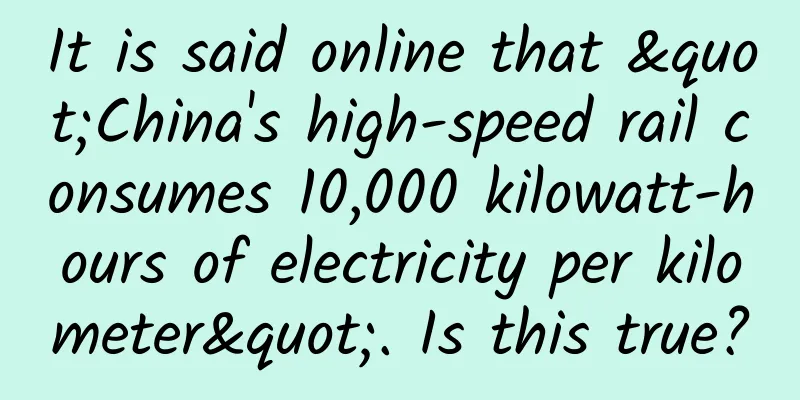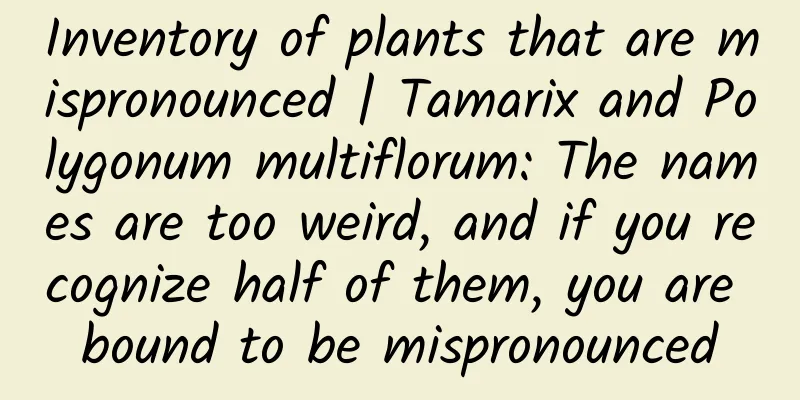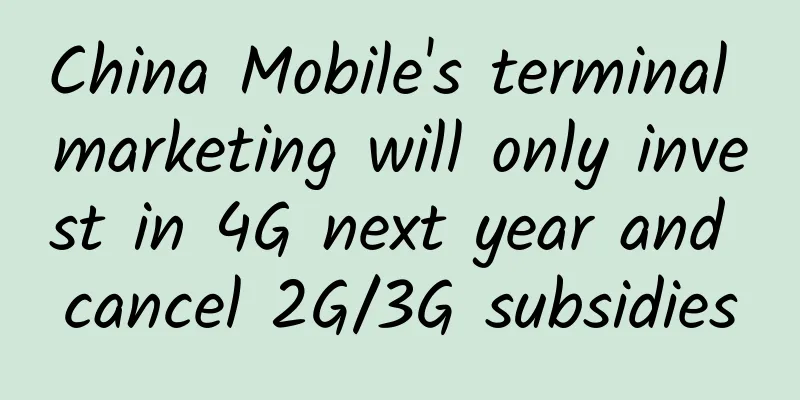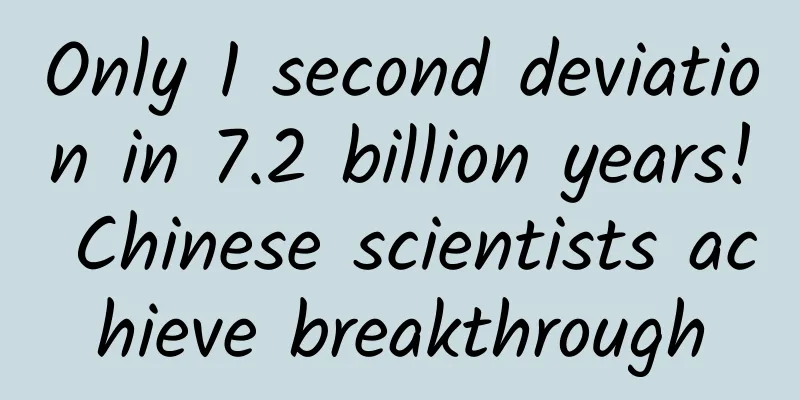It is said online that "China's high-speed rail consumes 10,000 kilowatt-hours of electricity per kilometer". Is this true?

|
Nowadays, high-speed rail has brought great convenience to our travel. However, along with the development of high-speed rail, remarks that smear and attack high-speed rail have also become rampant. Some rumors have even lasted for more than ten years, and they appear on the Internet from time to time, misleading many readers. The rumor that "high-speed rail consumes 10,000 degrees of electricity per kilometer" is a typical example. So, what is the energy consumption of China's high-speed trains? Let's use a high-speed rail energy consumption simulation calculation case to expose the rumor mongers. (Photo of China's high-speed rail Fuxing EMU: Xinhuanet) 1. How do you calculate the energy consumption of high-speed trains? The energy consumption calculation of high-speed trains involves many complex factors, including the train's traction power, train speed, train mass, running time, running distance and running environment. Generally speaking, it can be estimated by the following steps: First, collect data . We need to collect the average speed, average traction power and other relevant parameters of high-speed trains (such as train quality, marshaling, and capacity, etc.). Second, calculate the total energy consumption . If we know the average traction power of the train (in kilowatts) and the total time the train runs (in hours), we can calculate the total energy consumption (in kilowatt-hours) by the formula W = P × t, where W is the total energy consumption, P is the average traction power, and t is the running time. Third, calculate the energy consumption per kilometer . We divide the total energy consumption W by the total length of the high-speed railway L to get the energy consumption per kilometer (in kilowatt-hours/kilometer). That is, E (energy consumption per kilometer) = W (total energy consumption) / L (kilometer). Fourth, calculate the energy consumption per person per kilometer . We can divide the energy consumption per kilometer by the number of passengers on each high-speed train to get the energy consumption per person per kilometer (in kWh/person·kilometer). That is, N (energy consumption per person per kilometer) = E (total energy consumption) / number of passengers·L (kilometer). According to the above process, the energy consumption simulation calculation case of high-speed rail train is as follows (all data are simulated data and are for reference only): (1) High-speed train formation: 8 carriages, with a capacity of 576 people (estimated). (2) Average train speed: The average operating speed is 300 km/h. The actual operating speed may vary due to stopovers and speed adjustments. (3) Train running time: Calculated based on average speed, assuming that a high-speed rail line is 1,200 kilometers long, the required running time is 4 hours (1,200 kilometers / 300 kilometers/hour = 4 hours). If stops and acceleration and deceleration processes are taken into account, the actual running time will be longer. (4) Average traction power of train: Assume that the average traction power of the train is 8,000 kilowatts. The actual value may vary depending on factors such as train composition, load and speed. (5) Calculate the total energy consumption of the train: W (kWh) = average traction power P (kW) × running time t (hours) W = 8000 kilowatts × 4 hours = 32000 kilowatt-hours, or 32000 kilowatt-hours of electricity. (6) Calculate the energy consumption per kilometer of the train: Energy consumption per kilometer E (kWh/km) = Total energy consumption W (kWh) / Total distance L (km) E = 32000 kWh/1200 km ≈ 26.7 kWh/km, or about 26.7 kWh/km. (7) Calculate the power consumption per person per kilometer N (kWh/person/kilometer) = total energy consumption W (kWh) / (number of people × total distance L) N = 32,000 kWh/(576 people × 1,200 km) ≈ 0.046 kWh/person·km, or about 0.046 kWh/person·km. Through simulation calculations, we know that the high-speed rail train consumes about 26.7 degrees of electricity per kilometer during operation, and each person consumes about 4.6 degrees of electricity per 100 kilometers. I don't know where this low-level rumor that high-speed rail consumes 10,000 kWh of electricity per kilometer came from? So many people are still deceived! 2. Where does the rumor that high-speed rail consumes 10,000 kilowatt-hours of electricity per kilometer come from? It was the experts from the railway authority, the China Academy of Railway Sciences, who revealed the rumor mongers' trick: they were trying to switch concepts! Why? Because these people mistake the traction power of the train for the power consumption per kilometer of the train. The two are completely unrelated. For example, the traction power of the Fuxing high-speed train CR400BF is 10,140 kilowatts, and the power consumption of the train in one hour of operation is 10,140 kilowatt-hours (kWh). After actual calculations, the actual power consumption of this type of train per kilometer is only 21.1 kWh, which is not much different from the data we simulated earlier. (Source of the power consumption of different types of Chinese high-speed trains: China Railway WeChat Official Account) According to actual data provided by the railway department, the power consumption of high-speed rail is only 3.8 kWh per person per kilometer. High-speed rail is indeed fast and energy-saving! So, what are the "killer tricks" that high-speed trains use to save energy and reduce consumption? Let's take the Fuxing high-speed train as an example. 3. How do China’s high-speed trains save energy and reduce consumption? One is the low-resistance streamlined design. The front of the Fuxing EMU adopts a low-resistance streamlined and smooth design. This design is not only beautiful, but more importantly, it can significantly reduce air resistance, thereby reducing energy consumption. According to calculations, compared with traditional designs, the air resistance of Fuxing is reduced by about 10%, which is particularly effective for high-speed trains. The second is the lightweight body structure. Fuxing has optimized its body materials, using a large amount of lightweight materials such as aluminum alloy to effectively reduce the weight of the body. The reduction in body weight means that at the same speed, the train requires less traction, thereby reducing energy consumption. The third is the intelligent variable frequency air conditioning system. The Fuxing smart EMU uses advanced variable frequency air conditioning technology, which can automatically adjust the cooling or heating power according to the temperature inside the car, the number of passengers and other conditions, avoiding the "one-size-fits-all" mode of traditional air conditioning systems and effectively reducing energy consumption. According to statistics, this technology reduces the energy consumption of the air conditioning system by about 10%. The fourth is the energy feedback braking system. Fuxing uses energy feedback technology during braking, feeding the electrical energy generated during braking back to the power grid, thus realizing energy recycling. This technology not only reduces energy loss during braking, but also provides a certain amount of power support for the power grid. The fifth is to optimize operation and scheduling management. In addition to the energy-saving design of the vehicle itself, the operation and dispatching of Fuxing has also been optimized. By rationally arranging the departure intervals, running routes and stops of the trains, the idle time and waiting time of the trains are reduced, the operating efficiency is improved, and thus the energy consumption is indirectly reduced. Sixth, the application of green energy. Although Fuxing has not yet directly adopted green energy such as solar energy and wind energy as its power source, China's high-speed rail system is actively exploring the application of green energy. For example, in some high-speed rail stations and facilities along the line, solar photovoltaic panels have begun to be used to generate electricity to provide auxiliary energy support for the high-speed rail system. In the future, we believe that with the continuous advancement of science and technology and the increasing awareness of environmental protection, high-speed trains will make more breakthroughs in energy conservation and consumption reduction. High-speed trains will become more environmentally friendly, efficient and sustainable, thereby promoting a green revolution in the global high-speed rail industry. Author: Wang Lin, senior railway engineer, member of the Chinese Writers Association, member of the Chinese Science Writers Association Produced by: Science Popularization China |
Recommend
What impact will Israel’s “seawater flooding tunnels” have?
On December 4, the US media revealed that in orde...
Feng Qingyang Stock Market Practice Course 2
Resource introduction of Feng Qingyang's 2nd p...
How to do marketing promotion? Master these 14 methods!
Marketing promotion is never just about making pe...
Unboxing the 1,000-yuan Redmi Note
There are two versions of Redmi Note, both of whic...
Rabbits in the ocean
The Year of the Rabbit is here, and the streets a...
Do I still need to do cervical cancer screening after getting the HPV vaccine?
Recently, the National Health Commission pointed ...
Useful information丨7 pictures to help you master landing page optimization skills
What is a landing page ? What are the guidelines?...
How to do data analysis? 2 major analysis models and 6 data display charts!
What is Data Analytics ? Data analysis refers to ...
How to use and what to pay attention to when attracting traffic on Zhihu!
How to attract traffic to Zhihu ? This question i...
In the name of AI: Can Nvidia really rest easy with its skyrocketing stock price?
Recently, graphics chip manufacturer Nvidia relea...
How much does it cost to develop a Zhongshan musical instrument mini program?
According to industry insiders, mini programs wil...
Why is your information flow not effective? How to play information flow advertising?
How to play information flow advertising ? Who sh...
High-tech underwear for body wear! Is graphene underwear a waste of money?
"Dehumidification and sterilization", &...
How to write the insights section of a promotion plan?
As a creative planner, a core professional qualit...









